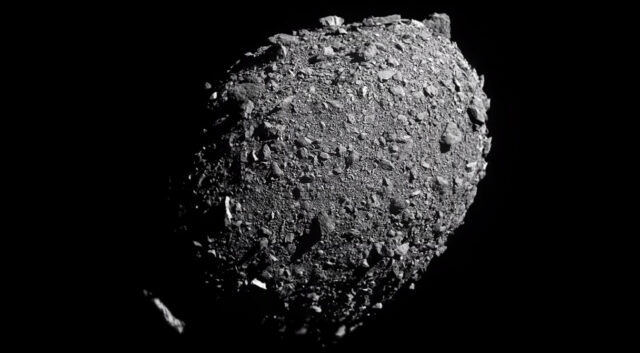NASA’s DART Asteroid-Smasher Is Gone, But We’ll Always Have These Stunning Images of Its Demise

Until recently, DART was a spacecraft about the size of a vending machine. Now, it’s debris scattered across the surface of a small asteroid called Dimorphos. This was very much the intention, though. NASA succeeded in smashing DART (Double Asteroid Redirection Test) into its target on Monday, Sept. 26. Now, scientists get to assess the data from the impact, including some stunning images of the event.
NASA live-streamed the big moment, which was the first real-life test of planetary defense technology. The idea is that a sufficiently large impactor spacecraft could change the orbit of a dangerous asteroid, ensuring that it doesn’t hit Earth. We would, of course, need a lot of warning to push an asteroid out of the way, but how much? And how big would the impactor need to be? Those are questions that DART could help answer.
This first-of-its-kind test was observed from a few angles, including from the DART spacecraft itself. It carried a camera known as DRACO that relayed images right up to the moment of impact. That’s important because scientists haven’t seen very many asteroids up close, and our previous assumptions about what they’re like have fallen short.
Did you catch the #DARTMission stream live or Didymos it? Impact is over, but the research continues. As scientists delve into data and telescopes release images of the asteroid from their POV, follow @AsteroidWatch and @NASASolarSystem for updates. https://t.co/ZNEYDQVA8Y pic.twitter.com/dn2veS6zbG
— NASA (@NASA) September 27, 2022
In the above footage, the surface of Dimorphos is strewn with rubble — it looks a great deal like the asteroid Bennu, which NASA recently visited with the OSIRIS-REx probe. The team behind that mission was surprised when they found the surface of Bennu to be so craggy that it was difficult to find a safe place for OSIRIS-REx to boop the asteroid. Japan found the asteroid Ryugu to be similarly uneven.
The first images from LICIACube, a small Italian Space Agency satellite, of the NASA #DARTMission striking the asteroid Dimorphos last night.
Photos: ASI / NASA pic.twitter.com/GM7O3K389g
— Michael Sheetz (@thesheetztweetz) September 27, 2022
Before beginning its death spiral, DART dropped off a small cubesat that could observe the event. The Italian-made LICIACube returned images of the impact as well, showing a sizeable burst of material emanating from Dimorphos. Its larger companion, Didymos, is visible in the frame.
Some ground-based observatories were watching the event as well. The ATLAS Project, a collaboration between NASA and the University of Hawaii, used the ATLAS 2 telescope to record the impact. It shows a large puff of material escaping the binary pair, which is visible even though it cannot resolve the individual asteroids.
ATLAS observations of the DART spacecraft impact at Didymos! pic.twitter.com/26IKwB9VSo
— ATLAS Project (@fallingstarIfA) September 27, 2022
While DART has done its job, this is only the beginning. There’s more data to collect, and the European Space Agency is preparing to send a probe to Didymos-Dimorphos that will further analyze the effects of the impact.
Now read:

Comments are closed.